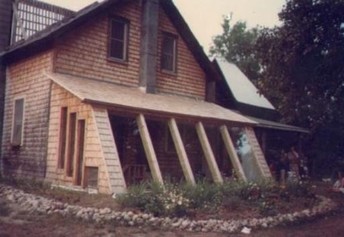|
With properly designed house right from the start it is conceivable to get most if not all your heating needs from the sun. This of course is very dependent on your climate and requires solar design from the ground up. Most of us do not have the luxury of building a passive solar house from the ground up so we have to suffice with adding on solar heat to our house.  There are many ways to do this but the methods can be broadly split up into two categories,
They both have many of the same design element and attributes the only real difference between them is that active uses electricity in some form to move the heat around. In this post I will briefly cover some examples of add on solar heating. Rooftop Heat Collectors Rooftop solar can be designed to heat either air before it enters your home or it can be used to heat water for your water heater which then depending on your heating system can be piped throughout your house to heat your home. To the left you can see a simplified diagram of solar water heating system. These types of systems can be added onto any existing structure and are a great way to make your home more environmentally friendly. They have m any benefits when compared to some other types of solar systems,
They can be considered unsightly however as there is very little to disguise the fact you have features designed to collect solar heat on your roof. This could be problematic if you live in a neighborhood that has those pesky rules about how your house has to look. Trombe Walls Trombe walls are an ancient technique that has been made better by modern technology. A trombe wall is essentially a very thick wall made of adobe, concrete, rammed earth or some other form of heavy earthen construction. This wall will typically be around 12 inches thick for most applications but your specific design needs should be taken into account when building one of these. How trombe walls work is something that is both amazing and incredibly simple. The masonry or earth that the wall is made of will absorb infrared heat from the sun at a rate of around one inch per hour. This heat is trapped and will slowly travel through the wall until is reaches the surface of the interior wall. This heat is then released into the living space of the house when it is needed the most at night. Now simple trombe walls can be made by just making sure that the south facing wall is uninsulated masonry of the appropriate thickness. This simple design can be made more efficient by using a glass cover offset from the wall itself and combination of well placed vents and fans. To move heated air air into the space and cool air back into the trombe wall Trombe walls are great addition for anyone looking to add solar heat to their house but they are not as easy to apply to every structure. They require specific sighting and foundation requirements that simply cannot be met by every homeowner or location. But if you can put one in there is very little that can go wrong with this system especially if you design it to be entirely passive utilizing air currents and natural convection. Add on Greenhouses Add on greenhouse, four season porch, sunspace these spaces have many names and can serve many purposes. Not every use is compatible with each other however. A perfect example is that a unheated and relatively uninsulated sunspace will not allow you to grow peppers in MN in winter. But that sunspace will provide a great heat capture for house when you want it to provide heat and there is a good chance it will be warm enough to start seedlings in the spring. There are many considerations when thinking about a add on greenhouse,
Below is a great book that will teach you all you need to know about add on a sunspaces or greenhouse to your home. Add on Solar Greenhouse and Sunspaces Sources: http://www.nrel.gov/docs/fy04osti/34279.pdf http://www.nrel.gov/docs/fy04osti/36277.pdf http://energy.gov/energysaver/sunrooms-and-sunspace
0 Comments
Leave a Reply. |
AuthorHello my name is Josh Larson and I am the creator of the Green Living Library. Here on the blog you will find updates to content found in the Green Living Library as well as stories from those living the sustainable life already. Archives
December 2021
Categories
All
|